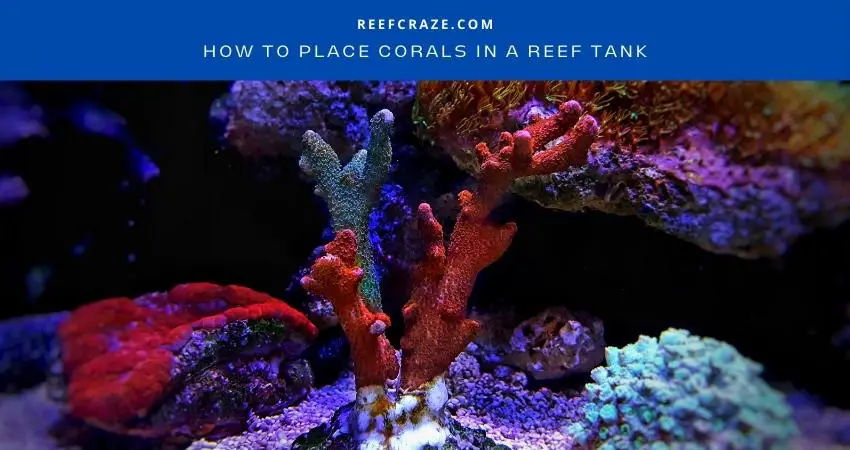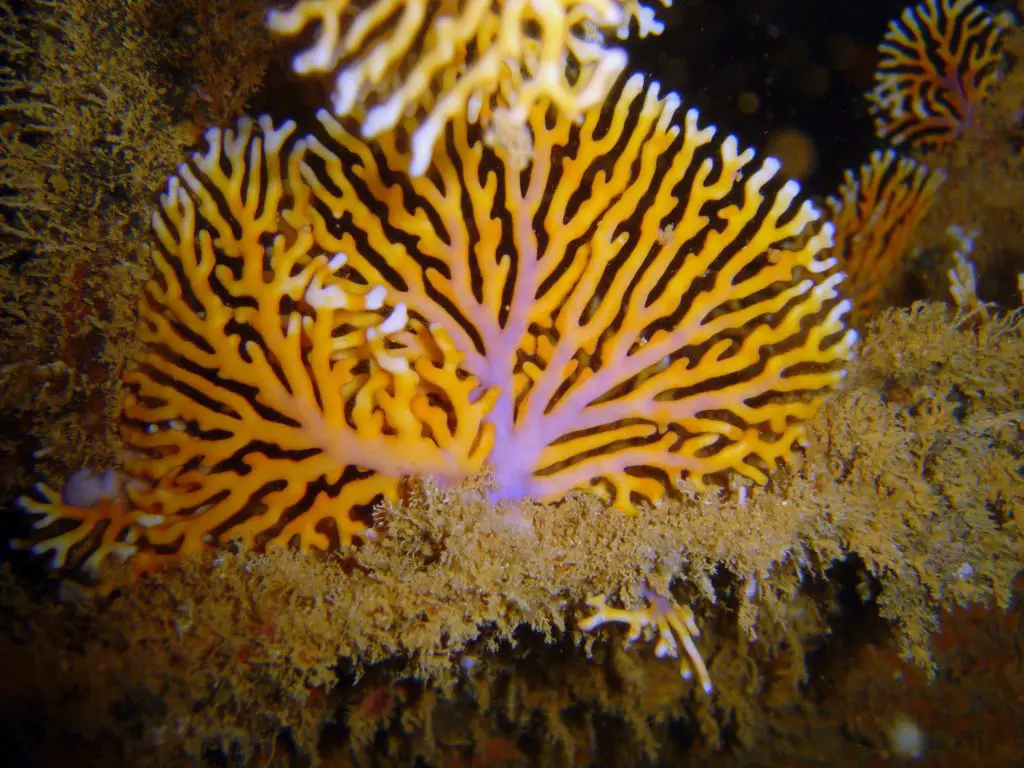Introducing corals to your new saltwater aquarium is undoubtedly one of the most exciting and fun steps of building a reef tank. It is rewarding to see how they look in the tank and get them the comfiest place there while they settle in the tank. It is as if all your efforts into getting your dream reef tank have finally been paid off.
Corals demand different types of environments, i.e., some need bright light, and others need to stay in the shady area of the tank. You have to set your tank accordingly to place them. Like other things about a reef tank, placing corals requires your thoughts and attention.
The subsequent sections will shed on the topic with more details regarding how to place corals in a reef tank.
When To Start Placing Corals In A Reef Tank?
You can start adding corals to your tank when it is done with its nitrogen cycle. That should roughly take 2 to 8 weeks. Nitrogen cycling and removing algae blooms will pave the way for adding corals as soon as possible. Observe the water parameters and introduce your corals only when the parameters are stable.

How To Place Corals In A Reef Tank?
SPS corals require one kind of treatment, and LPS and soft corals require another. So I will write about their placement individually.
SPS Corals
Uniquely shaped and vividly colored, SPS corals are treasures for any skilled hobbyist. Growing these corals is challenging, which signifies the importance of their placement even more.
SPS corals need bright light and high water flow, which means you have to keep them near the water surface. However, make sure their placement is low enough that they do not go beyond the surface while growing.
Below goes a list of SPS corals with their tank parameter requirement. Keep them in your mind if you want to have them in your aquascape.
Note that you want to let them adjust to your tank conditions when placing them first. Do not keep them under bright lighting from the beginning. That could cause coral bleaching.
1. Acropora
![How To Place Corals In A Reef Tank? [Beginner’s Guide] 1](https://reefcraze.com/wp-content/uploads/2022/04/acropora-1024x686.jpg)
- Water Flow: Medium-high
- Light Intensity: High
- Aggression: Medium-high
2. Distichopora

- Water Flow: Medium-high
- Light Intensity: Low
- Aggression: Low
3. Pocillopora
![How To Place Corals In A Reef Tank? [Beginner’s Guide] 2](https://reefcraze.com/wp-content/uploads/2022/04/pocillopora-1024x768.jpg)
- Water Flow: High
- Light Intensity: High
- Aggression: Low-medium
4. Psammacora
![How To Place Corals In A Reef Tank? [Beginner’s Guide] 3](https://reefcraze.com/wp-content/uploads/2022/04/Psammacora.webp)
- Water Flow: Low-Medium
- Light Intensity: High
- Aggression: High
5. Stylophora
![How To Place Corals In A Reef Tank? [Beginner’s Guide] 4](https://reefcraze.com/wp-content/uploads/2022/04/Stylophora.jpg)
- Water Flow: Medium-high
- Light Intensity: Medium-high
- Aggression: Medium-high
LPS And Soft Corals
On the contrary, LPS and Soft corals are not that sensitive to water flow and light. They actually prefer partially shaded locations with a lower water flow.
They will flourish if you place them lower in your aquarium or even bury them in the sand. Nonetheless, see that light reaches them somehow, although they will barely need it for their basic functions.
I have listed some of the most popular LPS and soft corals with their key requirements. Have a look if you are interested in bringing them into your tank.
1. Frogspawn
![How To Place Corals In A Reef Tank? [Beginner’s Guide] 5](https://reefcraze.com/wp-content/uploads/2022/04/Frogspawn-Coral-1024x683.jpg)
- Water Flow: Medium
- Light Intensity: Medium
- Aggression: High
2. Duncan
![How To Place Corals In A Reef Tank? [Beginner’s Guide] 6](https://reefcraze.com/wp-content/uploads/2022/04/Duncan-coral.jpg)
- Water Flow: Low-medium
- Light Intensity: Low-medium
- Aggression: Low
3. Pagoda Cup
![How To Place Corals In A Reef Tank? [Beginner’s Guide] 7](https://reefcraze.com/wp-content/uploads/2022/04/Pagoda-Cup-coral.jpg)
- Water Flow: Medium
- Light Intensity: Medium
- Aggression: Low
4. Tongue Coral
![How To Place Corals In A Reef Tank? [Beginner’s Guide] 8](https://reefcraze.com/wp-content/uploads/2022/04/Tongue-Coral.jpg)
- Water Flow: Low-medium
- Light Intensity: Medium
- Aggression: Medium
5. Brain Coral
![How To Place Corals In A Reef Tank? [Beginner’s Guide] 9](https://reefcraze.com/wp-content/uploads/2022/04/Brain-Coral.jpg)
- Water Flow: Low
- Light Intensity: Medium
- Aggression: High
Tank Water Parameters For Corals
Try to maintain the parameters as best as you can. If they are too low or too high, it will be detrimental to your corals. LPS corals are more tolerating than SPS corals. They can bear with phosphate and nitrate levels being a bit higher. As for temperature, the ideal range is 76 – 80° Fahrenheit.
| Temperature | 24 – 26°C (75-78°F) |
| Nitrite | 0 ppm |
| Nitrate | ~5 – 20 ppm |
| Ammonia | 0 ppm |
| Salinity | 35 ppt |
| Calcium | 350 – 450 ppm |
| pH | 8.0 – 8.4 |
| Alkalinity | 7 – 10 DKH |
| Phosphate | <0.15 ppm |
What To Consider Before Adding Corals?
Lighting
The first and foremost factor to consider is lighting. But do not arrange it randomly. First, decide on the type of coral you want to buy because, as I said, the lighting requirement varies from one to another.
Get quality lighting fixtures, especially if you get SPS corals. Lighting will help them grow and thrive by providing accurate radiation intensity to allow them to perform photosynthesis.
Flow Collision
When considering coral placement in your tank, you should pay much attention to the water flow setup.
Regardless of your arrangement, there will be places for two currents to meet. It is called flow collision. It will ultimately create a new current that is way stronger than the other two.
If you put corals in an area with flow collision, the clash between those two currents can jar the corals from their perches. So, be mindful of the flow strength and intersection point while planning the coral layout.
Filtration
It makes the tank environment humbler and more homogenous to enrich and support the aquatic life growing in your tank. The same applies to corals – they need standardized parameters, clean water, and zero toxicity, which call for a perfect filtration system.
Can I Mix SPS And LPS Corals?
Although you can do that, it is not highly recommended because placing them together is a daunting task. You have to put SPS corals in the upper areas and LPS corals near the middle to lower locations.
SPS corals are intolerable to aggression because of their requirements of lighting, feeding, reef habitat, and water flow.
So it is wise to keep only one of them. Otherwise, do your homework properly to learn about the corals of these two types that can stay in harmony inside the same reef tank.
Placing Different Corals
You need to prepare different areas known as zoning in your aquarium when bringing hard and soft corals.
The soft coral placement should be at the lowest part of the tank since they need less lighting and water flow. After them, you will put your LPS corals as their lighting and water flow requirements are higher than soft corals and lower than SPS corals.
Now mix the non-aggressive SPS and LPS corals with similar requirements at the top of your reef tank.
Important! If you also want to have reef fish in the same tank, bring only those who are not hostile to corals.
Final Words
It may look too challenging at first, but when you begin to get a hold of the process and introduce corals to your tank, things will become more comfortable.
You must have patience throughout the entire time while taking care of your tank water parameters to endure a healthy surrounding. When your corals become habituated to the tank and start striving, their aesthetical appeal will change the environment, both inside and outside your tank.
